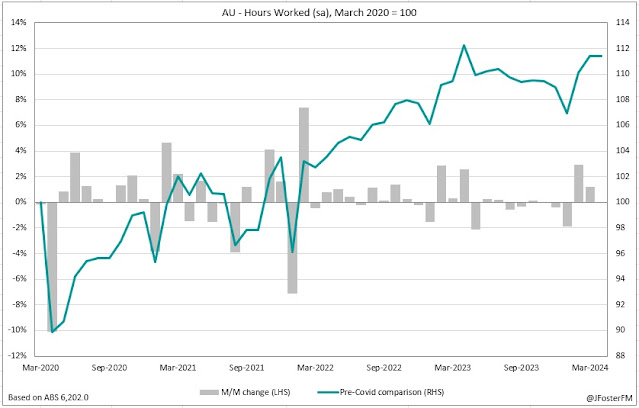Australia's monthly labour force survey for June is due this morning (11:30am AEST). Markets anticipate a rise in the unemployment rate to 4.1% from 4%, albeit driven by a slower rise in employment (20k) rather than job losses. Tighntness in the labour market has been easing gradually, broadly in line with RBA forecasts. The unemployment rate has trended up from cycle lows of 3.5% in 2022, though it remains at its lowest levels since 2008 and prior to that the 1970s. Meanwhile, job vacancies as a share of the labour force moderated to 2.4% in the latest data, down from a peak of 3.4% in 2022.
May recap: Unemployment fell back to 4% as employment beat expectations
Employment increased by a net 39.7k in May, comfortably outperforming the expected 25k rise on the back of a similar gain in April (37.4k). In the latest month, employment was driven by the full time segment (41.7k) as part time employment declined (-2.1k), a reversal of the composition seen in April (part time 45k/full time -7.6k).
After rising to 4.1% in April, the unemployment rate fell back to 4% in May. This was due to the net increase in employment (39.7k) exceeding the rise in the labour force (30.5k). In level terms, the participation rate was steady at 66.8%, close to the November 2023 record high (67%) and little changed over the past year.
A rise in illness-related absences weighed on hours worked in May (-0.5%m/m) following a 0.2% fall in April. The ABS estimated that 4.2% of employed Australians worked fewer hours than usual in the month, which compares to a pre-Covid average of 3.5% at the same time of year. Annual growth in hours worked has slowed significantly over the past 12 months from 5.2% to a 0.6% pace in May, a sign of adjustment in the labour market to the economic backdrop.
June Preview: Seasonal slowdown in employment anticipated
A moderation in employment to an increase of 20k is expected in June, with forecasts ranging from -20k to 40k. This would be a step down from the momentum of the past couple of months, but seasonal factors may be at play. The ABS's high-frequency payrolls index recorded a slower rise of 0.1% for the 4 weeks to mid-June, a similar movement to 12 months earlier. The Bureau noted that softer payrolls growth came after employment rebounded post the Easter and school holiday periods. Given the expectation for a moderation in employment, the unemployment rate is forecast to lift to 4.1%, based on the labour force participation rate remaining broadly unchanged (66.8%).




